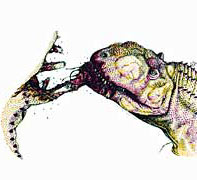An examination of bones in Madagascar has provided an explanation for the mystery of how the dinosaurs tried to survive when the Earth had a severe shortage of water and food
4.4.2003
By: Lior Kodner, Hatzer, Walla News

"Majonatulus" bites a dinosaur. The researchers examined the remains of the jaws and teeth. Illustration: National Science Association in the USA
Since 1896, the year in which giant bones were discovered in Madagascar, the island has served as a base for many studies dealing with dinosaurs. The island, which is located off the southeast coast of Africa, separated from the continent about 165 million years ago, which resulted in the development of a unique world of animals. One of the creatures that ruled the island 100 million years later, was a "Majunatulus" type dinosaur.
Over the years, researchers have wondered how Majonatulus managed to survive on the island, when his living conditions, like in other parts of the Earth, became particularly difficult. The solution to the mystery is provided today by American researchers in a study they published in the journal "Nature". According to them, Magonatulus survived, partly due to being a cannibal - an animal that eats its own kind. The study presents the first evidence of the existence of cannibalism among dinosaurs.
Over the years, many dinosaur researchers suspected the existence of cannibalism among the ancient animals, but no evidence of the phenomenon was found. According to the American researchers, the phenomenon increased at the end of the Cretaceous period. During this period - which began 142 million years ago and ended 65 million years ago - the earth was very dry. The harsh weather caused a severe shortage of water and food, and in order to survive the meat-eating dinosaurs had to resort to cannibalism.
The new research is based on tooth marks found on the bones of two dinosaurs in Madagascar. From measuring the spaces between the tooth marks and their shape, the researchers concluded that the marks were created by one dinosaur biting its own species. "To date, we have examined thousands of dinosaur bones from all over the world, but we have never found such unique fossils," explains the head of the research team, geologist Raymond Rogers from Minnesota.
Following the discovery, the researchers examined the remains of the jaws and teeth of all types of dinosaurs and crocodiles that lived at that time in Madagascar, and eventually came to the unequivocal conclusion that the teeth marks on the Majonatulus bones were created by the bites of another Majonatulus. "Unfortunately," emphasizes Rogers, "we cannot find out whether Meganatulus killed the two dinosaurs whose bones we found in Madagascar, or whether he just ate the remains of their bodies. It is also clear that Majonatulus followed the basic instinct of every animal - he wanted to survive at any cost. In the difficult period before the extinction of the dinosaurs, the natural resources at his disposal were greatly depleted. But Majonatulus did not resort to any means and in order to survive he had to eat his own kind for lunch as well."
According to archaeological findings, researchers believe that dinosaurs first appeared 230 million years ago. They ruled the earth for about 165 million years, until they became extinct very quickly. Studies conducted in recent years indicate that the extinction process lasted only about 10,000 years - a very short period of time in evolutionary terms.
Satellite images published last month by the American Space Agency (NASA) provided for the first time a scientific basis for the accepted theory about the extinction of the dinosaurs. According to the researchers, about 65 million years ago a meteor or comet collided with the earth. The collision caused environmental damage comparable to the detonation of 100 million hydrogen bombs at the same time. According to one approach, this collision ignited huge fires and caused the formation of a compressed dust cloud that blocked the sun's rays and caused the temperature on Earth to drop. According to another view, the dust storm caused acid rain that wiped out most of the animals on Earth.
Despite the negative image of cannibalism, the phenomenon is accepted among most animals. In times of ecological distress, cannibalism was also reported among humans in the past - even in the 20th century. The discovery of cannibalism among dinosaurs points to the antiquity of the phenomenon, which proves that it has been widespread on Earth for at least tens of millions of years.
